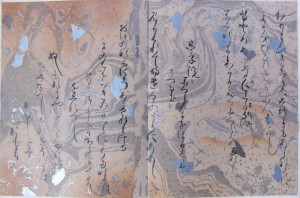The Next Poetry Broadside is Underway

Two pages of waka poems by Ōshikōchi Mitsune (859?-925?). 20cm height, 32cm wide. Silver, Gold, Color, and ink on suminagashi paper. From a copy of the Sanjurokunin Kashu or “Thirty-Six Immortal Poets” kept in the Hongan-ji Temple, Kyoto. This multi-volume manuscript, which contains the oldest examples of marbled paper known today, was presented to the Emperor Shirakawa on his sixtieth birthday in 1118 C.E.
“墨流し suminagashi, which means ‘floating ink’ in Japanese is the oldest method of decorative paper made with floating colors that is known today. Author Einen Miura states that the oldest reference to suminagashi papers are in the waka poems of Shigeharu, (825-880 CE), a son of the famed Heian era poet Narihira. Various claims have been made regarding the origins of suminagashi. Some think that it may have originally come from China. Others have proposed that it may have derived from an early form of ink divination. Another theory is that the process may have derived from a form of popular entertainment at the time, in which a freshly painted sumi painting was immersed into water, and the ink slowly dispersed from the paper and rose to the surface, forming curious designs.
One individual has often been claimed as the inventor of suminagashi. According to legend, Jizemon Hiroba felt he was divinely inspired to make suminagashi paper after he offered spiritual devotions at the Kasuga Shrine in Nara Prefecture. It is said that he then wandered the country looking for the best water with which to make his papers. He arrived in Echizen, Fukui Prefecture where he found the water especially conducive to making suminagashi. So he settled there, and his family carried on with the tradition to this day. The Hiroba Family claims to have made this form of marbled paper since 1151 CE for 55 generations.” (Wikipedia)
Our first session was a lesson in “how-to” – experimenting with various kinds of paper and ink, to see what would work best and produce the best results. We took turns both creating the ink patterns on the water, and laying down the paper on the surface. Effects were created using a traditional fan, a feather, and blowing through a pipette. We managed to produce eight finished pages over one evening. Now we only have to do forty-two more! Doesn’t it sound intriguing?
If you have some experience with suminagashi or other paper marbling and are interested in helping with the preparation of the paper, we are having other sessions of suminagashi at the print shop in the basement of Ludgate (Elspeth’s house) until the project is completed. Call (427-0760) if you would like to help!
We hope those of you who receive the finished second poem as your “perk” for new membership – or who have got the first broadside and intend to collect the rest – enjoy the results of our creative activity!
– Pat Chupa, Volunteer